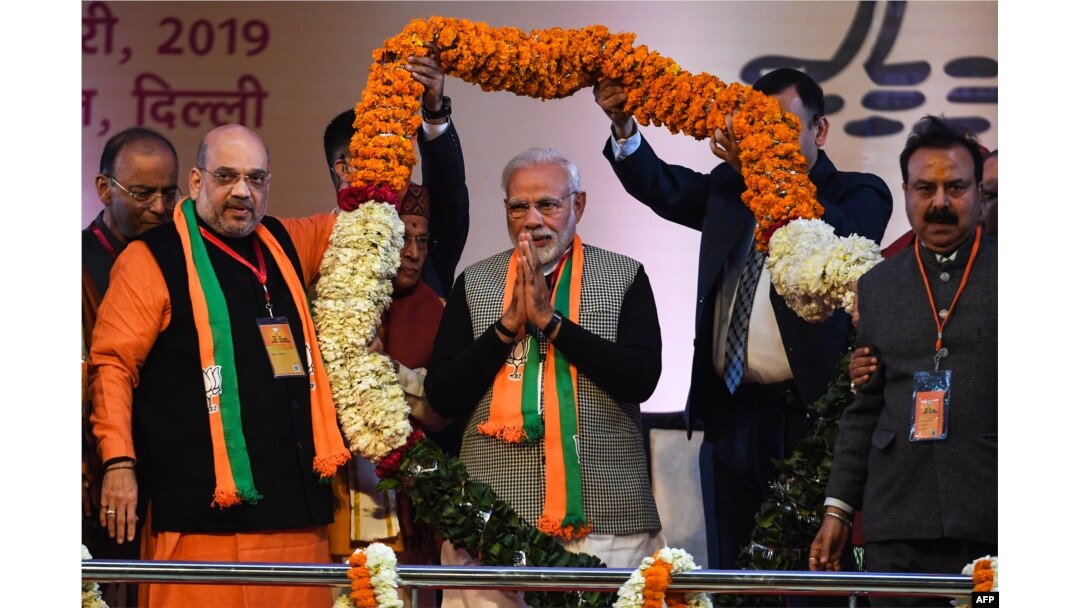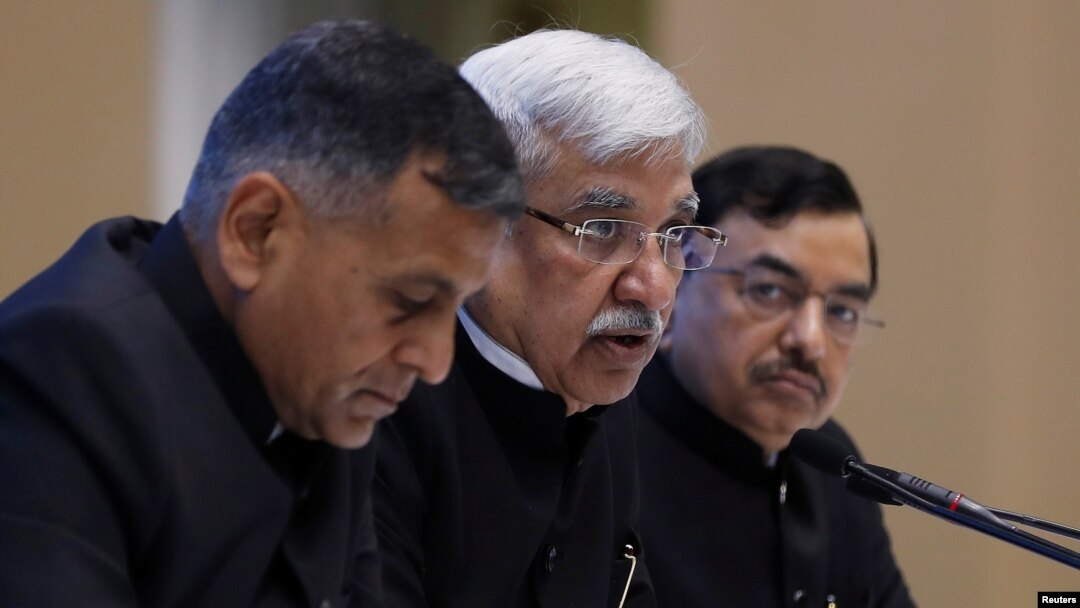India’s general elections will be held over five weeks weeks starting April 11 and decide if Prime Minister Narendra Modi, who won a sweeping victory five years ago, is able to secure a second term in office.
Billed as the world’s largest democratic exercise, as many as 900 million voters will be eligible to choose 543 members of the country’s lower house of parliament. The staggered election will be held in seven phases until May 19 and votes will be counted on May 23.

FILE - Indian Prime Minister Narendra Modi, center, is garlanded by BJP leaders on the first day of the two-day Bharatiya Janata Party national convention in New Delhi, Jan. 11, 2019.
The elections pit Modi’s rightwing Hindu nationalist Bharatiya Janata Party against the main opposition Congress party and an array of regional parties, some of who have formed alliances to challenge Modi.
While economic issues such as unemployment and farmers distress dominated the poll agenda until weeks ago, terrorism and national security have emerged as campaign issues after recent military skirmishes between India and Pakistan and could help Modi in his reelection bid as he projects himself as a strong leader.
Recent surveys say his popularity has risen since he ordered airstrikes inside Pakistan to target a militant camp following a suicide attack in Indian Kashmir.
SEE ALSO: India's Modi Taps Into Tide of Nationalist Sentiment as Elections LoomSeveral polls held earlier this year had suggested that the contest would be close and the BJP, which suffered key defeats in state elections in December, would struggle to win an outright majority as it battles perceptions that its economic performance has been patchy.
In a series of tweets after the announcement, Modi hailed the festival of democracy, called on first time voters to vote in record numbers and touted his achievements. “We spent the last five years fulfilling basic necessities that were left unfulfilled for 70 long years. Now, time has come to build on that and create a strong, prosperous & secure India,” he said.
As he announced the elections on Sunday, the country’s Chief Election Commissioner, Sunil Arora, outlined the logistical challenges of organizing a mammoth election involving an electorate bigger than the size of Europe and Australia, dozens of political parties and hundreds of candidates. “When independent India held its first election, not everyone was convinced of our capacity to conduct the exercise. But India emerged as a beacon light for emerging democracies. The scale and complexity of elections has only grown since then,” said Arora.
This year one million polling stations will be established throughout the country and more than five million government officials and security forces will be deployed. To ensure that every voter, whether on high mountain villages or inside forests is reached, officials sometimes have to travel by foot, helicopters and boats. The poll schedule has to take into account school exam dates, harvest times and festivals in different parts of the country.
With political parties starting to rely heavily on social media to influence voters and concerns about misuse of these platforms, the election commission is stepping up scrutiny of social media giants.
Chief Election Commissioner Arora said that companies like Facebook, Twitter, Google and YouTube have said they have appointed officers to take action against objectionable content posted on their sites and counter fake news and hate speeches. He said that all political advertisements on their platforms will be pre-certified by monitoring committees.
The election commission has also asked political parties not to use images of the armed forces in their campaign posters saying that they are “apolitical and neutral stakeholders in a modern democracy.”
The notice was issued after the ruling BJP used campaign posters with images of a captured Indian Air Force pilot who was returned by Pakistan after the recent clash between the neighbors.
The Election Commissioner dismissed concerns that have recently been expressed by some opposition parties that electronic voting machines used in Indian elections could be hacked and ballots rigged.


